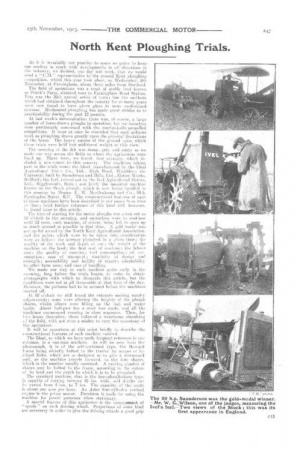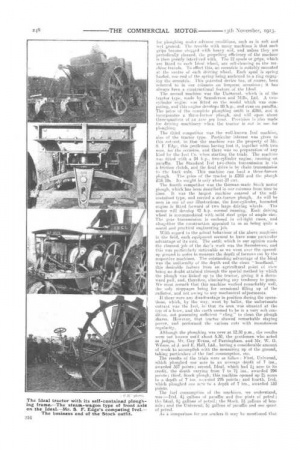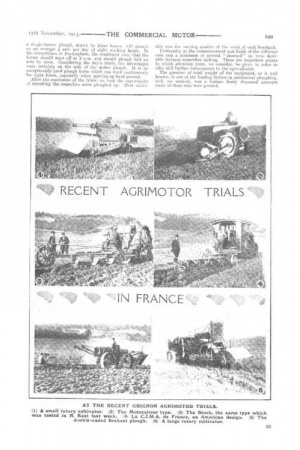North Kent Ploughing Trials.
Page 15

Page 16

Page 17

If you've noticed an error in this article please click here to report it so we can fix it.
As it is invariably our practice to spare no pains to keep cur readers in touch with developments in all directions in the industry, we decided, one day last week, that we would send a " CM.'' representative to the annual Kent ploughing competition, which this year took place, on Wednesday, 5th November, at Farningham, about three miles from Dartford.
The field of operations was a tract of arable land known as Frank's Farm, situated near to Yarningham Road Station. This was the 36th annual series of tests; but the methods which had obtained throughout the country for so many years were now found to have given place to more modernized systems. Mechanical ploughing has made great. strides as to practicability during the past 12 months.
At last week's demonstration there was, of course, a large number of horse-drawn ploughs in operation, but we ourselves were particularly concerned with the mechanically-propelled competitors. It must at once be conceded that such arduous work as ploughing draws greatly upon the physical limitations nf the horse. The heavy nature of the ground upon which these trials were held lent additional weight to this view. The morning of the 5th was damp, grey and misty as we made our way across the fields to where the agrimotors were lined up. 'There were, we found, four entrants, which included a new-comer to this country_ The machines taking part in the trials were : the Ideal, manufactured by the Ideal Agricultural ..1lotnr Co., Ltd., High Road, Wembley : the 'Universal, built by Saunderson and Mills. Ltd., Elstow Works, -Redford; the Ivel. turned out by the Ivof Agricultural Motors, Ltd., Biggleswade, Beds.; and lastly the imported machine known as the Stock plough, which is 1101N being handles] in Ibis country by Messrs. F. W. Moellenkamp and Co., 84-5, Farringdon Street E.C. The constructional features of each sf these machines have been described in our pages from time to time brief further reference of this kind will, however, be found later in this article.
The time of starting for the motor ploughs iris given out as 10 o'clock in the morning, and operations wore to continue until 12 noon, each machine, of course, being loft to open up as much ground as possible in thattime. A gold medal was I■ut up for award by the North Kent Agricultnra! Association, and the points which were to be taken into consideration were as follow : the acreage ploughed in a given time ; the quality of the work arid depth of cut ; the \ veight. of the machine on the land; the first cost of machine; the labour cost ; the qUalLy 01 ruIIning tail ee ption ; oil consumption; ease of transport ; simplicity of design and strength; accessibility. and -facility of repair ; adaptability to other farm .uses; and ease of handling.
We made our way to each machine quite early in the morning, long before the trials ,began, in order to obtain I hotographs with Which to illustrate this article, hut the conditions were not, at all favourable at that, time of the day. However, the pictures had to bc secured before the machines started off.
At 10 o'clock we still found the entrants making sundry adjustments; some were altering the heights of the .plough shares, whilst others were filling up the fuel and water tanks. About half-past ten a start was made, and all the machines commenced running in close sequence. Then, for two hours thereafter, there followed a wearisome circuiting, of the field, with not even a. misfire to vary the monotony of the operations.
It will be opportune at this point briefly to describe the constructional features of each machine entered.
The Ideal, to which we have made frequent reference in our columns, is a. one-man machine. As will be seen from the photograph, it is of the self-contained type, the Howard frame being directly bolted to the tractor by means of in clined links, which are no designed as to give a downward pull, as the machine travels forward, to the four shares, which is the number usually operated. A varying number of shares may be bolted to the frame, according to the nature of the land and the depth to which it is to be ploughed.
The standard machine, that is the four-plough-share type. is capable of cutting furrows 10 ins. wide, and depths can hi? varied from 4 ins. to 7 ins. The capacity of the outfit is about one acre per hour. An Aster four-cylinder vertical engine is the prime mover. Provision is made for using the machine for power purposes when stationary.
A special feature of this a,grimotor is the arrangement of "spuds " Oil each driving wheel. Projections of some kind are necessary in order to give the driving wheels a good grip
for ploughing under adverse conditions, such as in soft and wet ground. The trouble with many machines is that such grips become clogged with heavy soil, and unless they are periodically cleaned, the propelling efficiency of the machine is then greatly interfered with. The 12 spuds or grips, which are fitted to each Ideal wheel, are self-cleaning as the ma chine travels. To effect this, an eccentric is suitably mounted i at the centre of each driving wheel. Each spud s spring loaded, one end of the spring being anchored to a ring engaging the eccentric. This patented device has, of course, been referred to in our columns on frequent occasions; it has always been a constructional feature of the Ideal.
The second machine was the Universal, which is of the tractor type, made by Saunderson and Mills, Ltd. A twocylinder engine was fitted on the model which was competing, and this engine develops 20 h.p., and runs on paraffin. The price of the complete ploughing outfit is £265, and it incorporates a three-furrow plough, and will open about three-quarters of an acre per hour. Provision is also made for driving machinery when the tractor is not in use for ploughing.
The third competitor was the well-known Ivel machine, also of the tractor type. Particular interest was given to this entrant, in that the machine was the property of Mr. S. F. Edge, this gentleman having lent it, together with two men, for the occasion, and there was no preparation of any kind by the Ivel Co. when starting the trials. The machine was fitted with a 24 h.p., two-cylinder engine, running on paraffin. The Standard Ivel two-chain transmission is via a friction clutch, and the final drive is by chain transmission to the back axle. This machine can haul a three-furrow plough. The price of the tractor is £355 and the plough £16 10s. Its weight is only about 37 cwt.
The fourth competitor was the German-made Stock motor plough, which has been described in our columns from time to time. It was the largest machine entered of the selfcontained type, and carried a six-furrow plough. As will be seen in one of our illustrations, the four-cylinder, bonneted engine is fitted forward of two large driving wheels. The motor will develop 42 h.p. normal running. Each driving wheel is accommodated with mild steel grips of ample size. The gear transmission is enclosed in oil-tight cases, and altogether the construction appealed to us as being quite a sound and practical engineering job.
With regard to the actual behaviour of the above machines in the field, each equipment seemed to have some particular advantage of its own. The outfit which in our opinion made the cleanest job of the day's work was the Saunderson, and this was particularly noticeable as we went over the openedup ground in order to measure the depth of furrows cut by the respective machines.. The outstanding advantage of the Ideal was the uniformity of the depth and the clean " headland," this desirable feature from an agricultural point of view being no doubt attained through the special method by which the plough was linked up to the tractor, giving it a downward pull, and, therefore, eliminating any tendency to jump. We must remark that this machine worked remarkably well, the only stoppages being for occasional filling up of the radiator, and not owing to any mechanical adjustments. , If there were any disadvantage in position during the operations, which, by the way, went by ballot., the unfortunate entrant was the Ivel, in that its area was situated at the top of a brow, and the earth seemed to be in a very soft condition, not possessing sufficient " cling " to clean the plough shares. However, that tractor showed remarkable staying power, and performed the various cuts with monotonous regularity.
Although the ploughing was over at 12.30 p.m., the results were not known until about 5.30, the gentlemen who acted as judges, Mr. Guy Evans, of Farningham, and Mr. W. G. Wilson, of J. and E. Hall, Ltd., having a considerable amount of work to accomplish with the measuring up of the ground, taking particulars of the fuel consumption, etc.
The results of the trials were as follow : First, Universal, which ploughed one acre to an average depth of 7 ins., awarded 357 points; second, Ideal, which had 1* acre to its credit, the depth varying from 7 to 7 ins., awarded 294 points; third, Stock plough, this machine opened up 2* acres to a depth of 7 ins. awarded 276 points ; and fourth, Ivel,, which ploughed one acre to a depth of 7 ins., awarded 158 points.
The fuel consumption of the machines, we understand, was :—Ivel, 44 gallons of paraffin and five pints of petrol; the Ideal, 6 gallons of petrol ; the Stock, 8* gallOns of hensole; and the Universal, 5* gallons of paraffin and one quart of petrol.
As a comparison for our readers it may be mentioned that a single-furrow plough, drawn by three horses. ‘vill plough on an average acre per day of eight. working hours. In the competition at. Farningham, the ormditions were that the horses should start off at 8 a.m. and should plough half an acre by noon. Considering the day's trials, the advantages were certainly on the side of the motor plough. It is an exceptionally good plough horse which can work continuously for eight hours, especially when opening up hard ground.
After the conclusion of the trials, we took the opportunity of circuiting the respective areas ploughed up. Most notice able was the varying quality of the work at each headland. -Uniformity at the commencement and finish of the different cnts and a minimum of ground " churned" up were desirable features somewhat lacking. Those are important points to which attention must, we, consider, be given in order to offer still further inducements to the agriculturist..
The question of total weight. of the equipment, as is well known, is one of the leading factors in mechanical ploughing, and, we noticed, was a feature freely discussed amongst many of those who were present.
























